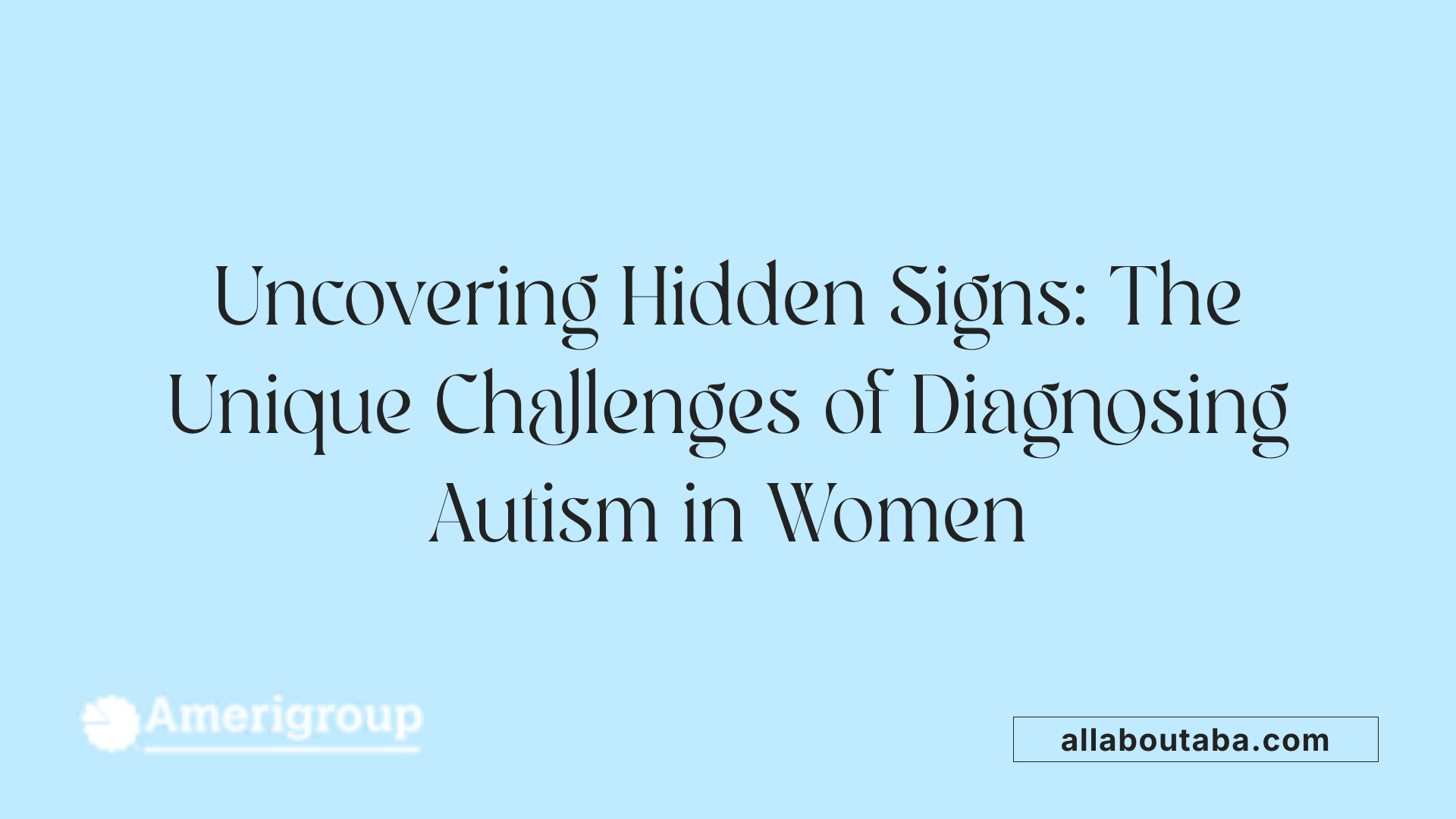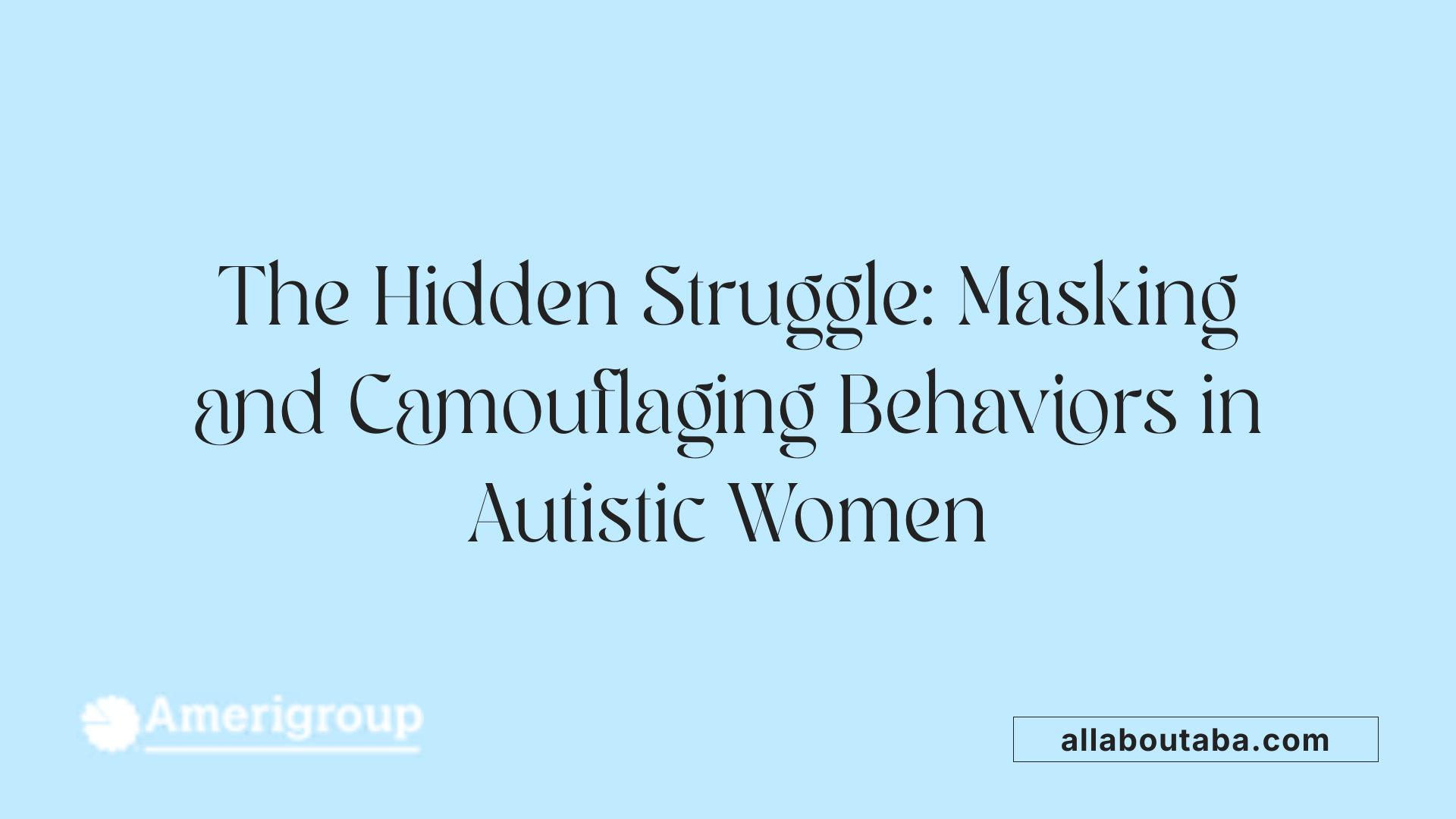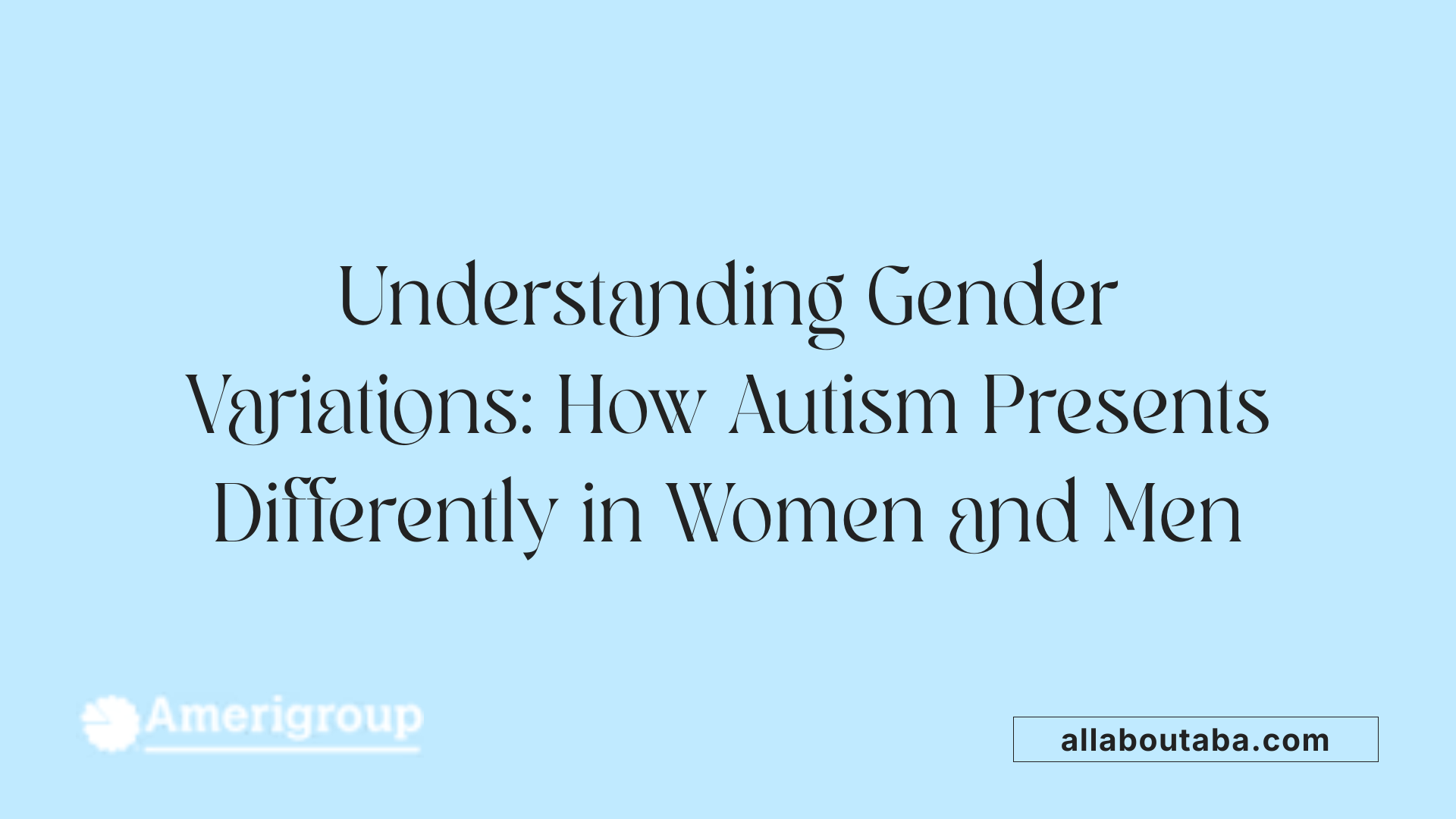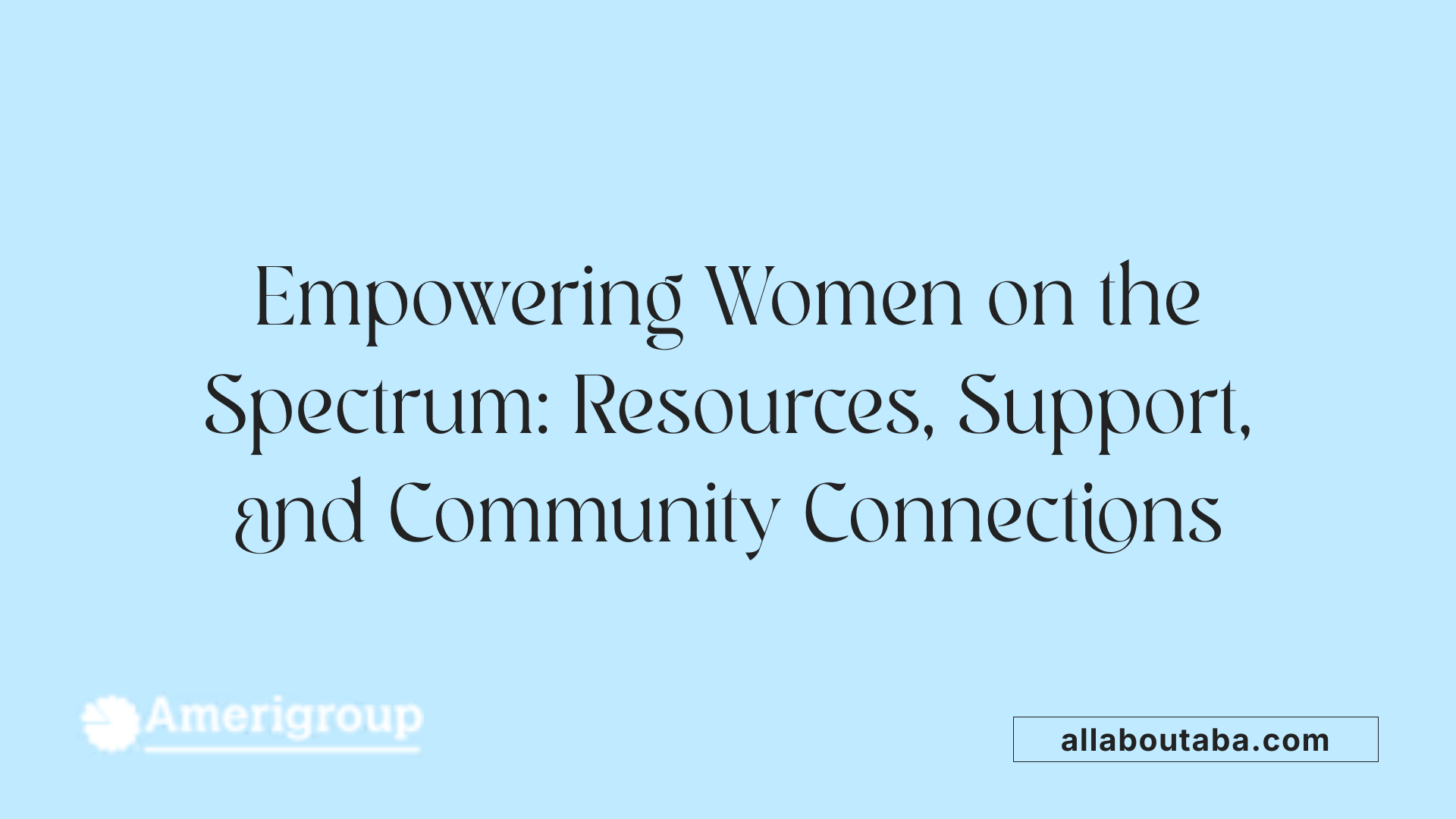Autism In Women
Understanding Autism Beyond Stereotypes
Autism Spectrum Disorder (ASD) is widely recognized as a neurodevelopmental condition affecting social interaction, behavior, and communication. While traditionally associated with males, emerging research reveals that autism in women manifests differently—often more subtly, internalized, and masked. This article explores the distinctive features of autism in women, the challenges in diagnosis, societal influences, and the resources available to support autistic women.
Understanding the Manifestation of Autism in Women and Girls

What are the typical signs and traits of autism in women?
Autistic women often show signs that are less obvious than those typically seen in males, which can make diagnosis more difficult. Many exhibit internalized symptoms, including social challenges like difficulty understanding social cues, communicating effectively, or forming close relationships. Sensory sensitivities—such as heightened reactions to bright lights, certain textures, or loud noises—are common.
Difficulties with executive functions, such as organizing tasks, managing time, or emotional self-regulation, are also prevalent. Many develop intense interests, but these may be socially acceptable or more subdued compared to stereotypical male interests. Camouflaging behaviors, like mimicking social behaviors, rehearsing conversations, or suppressing natural reactions, are widely used to blend in.
Other signs involve sleep disturbances, repetitive behaviors, and problems with emotional regulation, often leading to anxiety or depression. Many women experience co-occurring mental health issues, which can be linked to the effort they put into masking their traits and navigating social environments.
Overall, autism in women often manifests as an internal experience with subtle outward behaviors, requiring a nuanced understanding for proper recognition.
How does autism manifest specifically in women and girls?
In females and girls, autism frequently manifests through hidden or internalized behaviors that are not immediately recognizable. These individuals may actively mask or camouflage their difficulties, mimicking social behaviors, rehearsing responses, or avoiding behaviors that might reveal their struggles.
Unlike their male counterparts, they might have fewer stereotypical repetitive movements and interests that stand out. Instead, they develop socially acceptable interests like animals, art, or literature, and tend to have better social awareness.
However, these compensatory strategies often come at a cost—leading to exhaustion, anxiety, or burnout. They may also develop elevated anxiety or internalized depression since they struggle with feeling misunderstood and overwhelmed.
Sensory sensitivities—such as discomfort from textures or sounds—are common but may be hidden behind their efforts to appear typical. Challenges with executive functioning, like difficulty transitioning between tasks or organizing routines, are also seen but often disguised.
Most importantly, this internalized presentation results in delayed or missed diagnoses, especially in individuals with average or higher intelligence, as their outward behaviors don’t fit the traditional stereotypes.
By understanding these subtle and internalized patterns, clinicians and supporters can better identify autism in women and girls, ensuring they receive the support they deserve.
Challenges in Diagnosing Autism in Women

What are the challenges in diagnosing autism in women?
Diagnosing autism in women presents unique difficulties rooted in the way symptoms often manifest differently compared to men. Traditionally, autism has been viewed through a male-centric lens, leading to diagnostic criteria and assessment tools that are based on male presentations of the disorder. As a result, many women display subtler symptoms that are less recognizable or are easily masked.
One major challenge arises from the tendency of autistic women to employ camouflaging or masking behaviors. This includes mimicking social behaviors, rehearsing conversations, or forcing eye contact to blend in with neurotypical peers. These strategies, although helpful socially, are highly taxing and can lead to mental exhaustion, anxiety, depression, and burnout.
Because their outward behaviors may appear typical or even socially adept, clinicians often overlook or misinterpret their struggles. The mental effort involved in masking is rarely acknowledged during evaluations, which can cause clinicians to underestimate the person's difficulties.
In addition, current diagnostic assessments are primarily designed around stereotypical male traits such as overt repetitive behaviors and clear social communication challenges. Female symptoms often involve internalized characteristics like anxiety, mood disorders, or unique interests that are socially acceptable, making autism less visible.
Further complicating diagnosis are co-occurring mental health conditions that generally mimic or overshadow autism symptoms. Anxiety, depression, eating disorders, and other psychiatric conditions frequently occur alongside autism in women. These can mask the underlying neurodevelopmental disorder and lead to misdiagnosis or delayed diagnosis.
Consequently, many autistic women remain undiagnosed until adulthood, sometimes after decades of struggling with mental health issues or social difficulties. This delay can hinder access to necessary support and interventions, impacting overall well-being.
Understanding these multifaceted challenges underscores the need for refined diagnostic criteria and increased awareness among healthcare professionals to ensure accurate identification and support for women on the autism spectrum.
| Aspect | Description | Impact |
|---|---|---|
| Diagnostic Bias | Traditional tools focus on male traits such as overt repetitive behaviors | Misses subtler or internalized symptoms in females |
| Masking Behaviors | Camouflaging social difficulties and mimicking others | Increased fatigue, anxiety, burnout |
| Presentation | Less stereotypical and more socially acceptable interests | Leads to misdiagnosis or oversight |
| Co-occurring Conditions | Mental health issues like anxiety and depression | Conceal autism traits, delay diagnosis |
| Gender Stereotypes | Stereotypes affect clinician perceptions | Underdiagnosis and misdiagnosis |
This pattern of under-recognition emphasizes the importance of tailored assessment strategies that consider gender-specific expressions of autism, aiming for earlier and more accurate diagnosis for women.
Autism Masking and Camouflaging Behaviors in Females and Their Significance

What is autism masking or camouflaging in females, and why is it significant?
Autism masking, also known as camouflaging, refers to the strategies females with autism often use to hide or compensate for their autistic traits. This behavior involves actively mimicking social behaviors, rehearsing interactions, and using scripted responses to appear more neurotypical. Females may suppress natural behaviors such as stimming—repetitive movements or sounds that help regulate sensory input and emotions—and force themselves to make eye contact during conversations.
Common masking behaviors include mirroring facial expressions, adopting socially accepted gestures, and hiding intense interests or routines that are typically associated with autism. These actions are driven primarily by a desire to fit in, avoid social rejection, or prevent bullying. Many women learn to imitate social cues and suppress behaviors that might reveal their neurodivergence.
The significance of masking cannot be overstated. It often makes autism in females less visible to healthcare providers, educators, and peers. As a result, many women go undiagnosed or receive diagnosis late in life, sometimes only after significant mental health issues arise, such as anxiety and depression. Masking also exacts a significant mental toll, leading to exhaustion, stress, and burnout.
Understanding masking behaviors is essential for improving diagnostic accuracy and providing appropriate mental health support. Recognizing these hidden behaviors emphasizes the need for a nuanced approach to supporting autistic women, acknowledging that their outward calm or social ability may conceal underlying difficulties.
Overall, masking and camouflaging are key factors contributing to the underrepresentation of females in autism statistics and highlight the importance of tailored assessment tools and increased societal awareness. Better understanding these behaviors helps foster acceptance, reduce stigma, and improve access to resources for women navigating life on the spectrum.
Biological and Neurobiological Factors in Autism in Women
Are there biological or neurobiological factors associated with autism in women?
Research indicates that biological and neurobiological factors significantly influence how autism manifests in women. These factors include genetic influences, brain connectivity differences, hormonal effects, neuroanatomical variations, and neurotransmitter system differences.
Genetic influences
Genetics play a crucial role in autism, with recent studies showing sex-specific gene expression patterns. Females with autism often exhibit different genetic profiles compared to males, which may contribute to the gender disparity in diagnosis rates. The female protective effect suggests that girls and women may require a higher genetic load or additional biological factors to develop autism, which partly explains their underdiagnosis.
Brain connectivity differences between sexes
Neuroimaging studies reveal that patterns of brain connectivity differ between autistic males and females. Unlike the earlier Extreme Male Brain Theory, recent research highlights that women with autism may display more typical or even enhanced social cognition skills, facilitated by distinct neural networks. These differences indicate that autism in women may involve alternative brain pathways that compensate for certain social or behavioral challenges.
Hormonal influences and reproductive factors
Hormones like estrogen and progesterone influence brain development and may affect autism traits in women. Variations in menstrual cycles, reproductive health conditions such as polycystic ovary syndrome (PCOS), and pregnancy-related hormonal changes have been linked to differences in autistic behaviors and sensory sensitivities. These hormonal factors can also impact emotional regulation and executive functioning.
Neuroanatomical variations
Structural brain differences, such as variations in the size and connectivity of the amygdala, frontal cortex, and corpus callosum, are observed in women with autism. These neuroanatomical features can contribute to differences in social processing, communication, and sensory integration.
Neurotransmission differences
Differences in neurotransmitter systems, particularly serotonin and GABA, have been identified in women with autism. These chemical systems influence mood, anxiety, and neural plasticity, potentially explaining the prevalence of internalized symptoms like anxiety and depression that are common in autistic women.
Research on sex-specific biological factors
Ongoing research emphasizes that autism is not a one-size-fits-all condition but varies considerably across genders. Scientific investigations using genetics, neuroimaging, and hormonal assays are revealing complex, sex-specific biological underpinnings. These insights aim to improve diagnostic accuracy, develop targeted interventions, and enhance support tailored to women’s unique neurobiological profiles.
Understanding these biological nuances is essential for advancing diagnostic criteria and developing personalized support strategies. Recognizing that autism in women involves distinct neurobiological and genetic factors helps to counteract stereotypes and promote a more inclusive, evidence-based approach to diagnosis and treatment.
| Biological Factor | Description | Impact on Autism in Women |
|---|---|---|
| Genetic Influences | Sex-specific gene expression patterns | May contribute to resilience or delayed diagnosis |
| Brain Connectivity | Differences in neural networks | Affects social cognition and compensatory skills |
| Hormonal Influences | Estrogen, progesterone, reproductive hormones | Impact mood, sensory sensitivities, and social behaviors |
| Neuroanatomical Variations | Structural brain differences | Influence social and emotional processing |
| Neurotransmitter Systems | Serotonin, GABA differences | Affect mood, anxiety, and internalized symptoms |
This growing body of research underscores the importance of considering biological sex differences when studying autism. It moves the focus toward more gender-sensitive diagnostic tools and interventions that recognize the unique neurobiological landscape in women with autism.
Gender Differences in Autism Presentation and Diagnostic Disparities

What are the differences in autism presentation between women and men?
Autism manifests differently in women and men, largely due to biological, social, and cultural factors. Women with autism tend to display fewer obvious behaviors associated with the condition, often masking their symptoms through social mimicry and learned behaviors. This masking can include rehearsed phrases, mimicking facial expressions, and suppressing natural behaviors like stimming.
Unlike their male counterparts, autistic women often have interests that align with societal expectations, such as animals, art, or literature, making their intense interests less noticeable and easier to hide. They also develop stronger social imitation skills, enabling them to appear more socially typical, which can delay identification of their autism.
These differences are exacerbated by diagnostic criteria historically based on male behaviors. As a result, many women and girls are underdiagnosed or diagnosed later in life. Subtler signs—such as internalized anxiety, less overt repetitive behaviors, and better social adaptation—contribute to this misrecognition.
Hormonal influences and gendered social expectations further shape how women experience autism. These factors can lead to a higher prevalence of co-occurring mental health issues like anxiety and depression, which might overshadow or mimic autistic traits.
How do societal expectations influence autistic traits in females?
Societal expectations play a significant role in shaping how autistic traits are expressed and perceived in women. From a young age, girls are often socialized to conform to norms of sociability, emotional expressiveness, and politeness.
This socialization encourages behavior masking and camouflaging, which can be exhausting but effective in blending into social environments. While this helps women navigate social expectations, it often results in internal stress, social fatigue, and mental health challenges like anxiety or depression.
Because women tend to internalize their struggles more than men, their autistic traits may manifest as heightened sensitivities, emotional regulation difficulties, and internal distress, rather than obvious behavioral differences.
Why have diagnostic criteria historically focused on male traits?
Diagnoses of autism have traditionally centered around stereotypical behaviors more commonly observed in males, such as overt repetitive movements, physical tics, and unmistakable social challenges. This male-centric focus stems from early research and assessment tools developed primarily from studies of boys.
As a result, many females with autism display less stereotypical behaviors, or their behaviors are masked or internalized. This discrepancy has led to a significant underrecognition of autism in women and girls, who often do not meet these stereotypical criteria at first glance.
Furthermore, clinical assessments might overlook subtle indicators like internalized anxiety, difficulties with social reciprocity, or special interests that are socially acceptable, adding to diagnostic challenges.
Are there common misdiagnoses or late diagnoses among women?
Yes, many women with autism are misdiagnosed or receive their diagnosis later in life. Common misdiagnoses include borderline personality disorder, social anxiety, ADHD, and depression, as their symptoms often overlap.
The average delay in diagnosis for women can be around ten years from initial mental health presentations, which hampers timely support and intervention. This delay is partly because women tend to develop coping strategies—like masking and camouflaging—that hide their deficits.
Late diagnoses often leave women feeling misunderstood, isolated, and overwhelmed, with increased risks of mental health issues. Recognizing these disparities is crucial for improving diagnostic accuracy and providing appropriate support.
How do hormonal and social influences affect how women experience autism?
Hormonal differences, especially related to estrogen and progesterone, may influence neural development and autistic traits, although research is ongoing. These biological factors can modulate sensory sensitivities, emotional regulation, and social behaviors.
Social influences also have a profound impact. From childhood, girls are encouraged to be nurturing, sociable, and communicative. These expectations motivate behaviors like social masking and suppression of autistic traits.
Consequently, women may internalize their difficulties, which contributes to heightened internalized mental health issues such as anxiety and depression. They might also develop interests aligned with social norms, which serve as socially acceptable outlets for their focus and passions.
While these internal and external influences help women adapt socially, they often come at the cost of increased emotional burden and delayed recognition of autism. Overall, understanding these gender-specific influences enhances awareness and aids in developing more inclusive diagnostic criteria and support systems.
Resources and Support for Women with Autism

What resources and support options are available for women with autism?
Women with autism have access to a range of specialized resources designed to address their unique challenges and needs. These include tailored therapeutic interventions such as cognitive-behavioral therapy (CBT) focused on social skills, emotional regulation, and sensory processing. Support organizations and community groups play a vital role, offering peer connections and platforms for sharing experiences.
Prominent organizations like the Autistic Women & Nonbinary Network (AWN) and Autism Speaks provide targeted programs, including support groups, advocacy efforts, and educational resources. These organizations help women recognize their own traits, understand their condition, and find community support.
Community-based programs such as Women with Asperger’s Meetup and local support groups are specifically designed to foster social connection among women and girls on the spectrum. These groups offer a safe space for sharing experiences and coping strategies, helping to combat feelings of loneliness and social exclusion.
Awareness campaigns and advocacy initiatives are crucial in promoting understanding of how autism presents differently in women. These campaigns work to reduce stigma, encourage early diagnosis, and promote acceptance in society.
Educational resources, including online courses, informational websites, and books, are essential for empowering women with knowledge about their autism. Such resources can facilitate self-understanding and guide individuals toward appropriate supports and accommodations.
Understanding the importance of early diagnosis and intervention is fundamental. Early access to therapies and support can significantly improve social skills, mental health, and overall quality of life. Recognizing less obvious signs and ensuring comprehensive assessments are critical steps in this process.
Support options extend beyond therapy and support groups. Schools, workplaces, and community centers are increasingly adopting accommodations such as sensory-friendly spaces, flexible scheduling, and awareness training to better include women with autism.
In summary, resources and support options are diverse and evolving to meet the specific needs of women and girls on the spectrum. They play a key role in fostering self-acceptance, improving mental health, and enabling greater independence.
Towards a More Inclusive Understanding of Autism in Women
Recognizing and understanding autism in women requires acknowledging the unique ways it manifests—often subtly and with masked behaviors. Misdiagnosis and late diagnosis remain challenges, but increased awareness, refined assessment tools, and societal shifts can improve support and acceptance. By embracing the diversity of autistic presentations across genders, we pave the way for more inclusive, empathetic, and effective approaches to diagnosis, intervention, and community support. Celebrating the lived experiences of autistic women not only broadens our understanding but also promotes a society that values neurodiversity in all its forms.
References
- Understanding undiagnosed autism in adult females - UCLA Health
- Autism in Women: Symptoms, Causes, Diagnosis, and Treatment
- Signs of autism in adults - NHS
- Women in Autism
- 10 Signs of Autism in Women | Psychology Today Canada
- Autistic women and girls
- Female autism checklist | Oxford CBT
- How is Autism Different in Women? - Adult Autism Health Resources
- Signs of autism in women and girls
- What are the main signs of autism masking in women?
Other articles
Recent articles

How Schools Can Support Autistic Students In Career Prep

Best Strategies For Autism-Friendly Event Planning

Understanding Noncontingent Reinforcement In Autism Behavior Plans

How Drama Therapy Benefits Autistic Individuals

Best Practices For Autism-Friendly Fitness And Recreation Centers

Best Ways To Promote Healthy Social Media Use For Autistic Teens

How To Help Autistic Children Cope With Public Speaking

Autism And Strategies For Managing Unexpected Changes

Best Podcasts About Autism For Parents And Educators

Autism And The Impact Of Seasonal Changes On Behavior

The Role Of Diet In Managing Co-Occurring Conditions With Autism

Sleep Challenges In Autism And Practical Solutions

Best Ways To Build Daily Routines For Autistic Children

Best Practices For Supporting Autistic Entrepreneurs

Autism And Strategies For Navigating Large Social Gatherings

Adaptive Sports And Recreational Activities For People With Autism

Autism And The Benefits Of Story-Based Learning Activities

Understanding The Role Of Play In Autism Development

Autism And The Impact Of Environmental Noise On Learning

How To Create Autism-Friendly Community Spaces

Autism And Chronic Health Conditions: What To Know

The Role Of Care Managers In Autism Life Planning

How To Teach Social Boundaries To Autistic Children

How Autistic Individuals Experience Empathy Differently

How To Support Autistic Employees In Remote Work Settings

Autism And The Relationship Between Motor Skills And Learning

How To Create Community Resource Guides For Autism Families

How To Teach Daily Living Skills To Autistic Teens

Autism And The Impact Of Mind-Body Practices On Stress Reduction

Autism And The Benefits Of Outdoor Group Activities

How To Create Autism-Friendly Sensory Paths In Schools

Best Practices For Autism-Friendly Park And Recreation Areas

Autism And Strategies For Reducing School Refusal

Supporting Autistic Individuals In Public Speaking

The Role Of Diet In Managing Autism Symptoms

The Benefits Of Gardening Clubs For Autism Social Development

How To Prepare Autistic Children For Dental Visits

Autism And Employment: Career Paths That Work

Best Practices For Autism-Friendly Hotels And Lodging

The Impact Of Screen Time On Autism Development

Autism Screening Tools For Early Childhood

The Role Of Physical Exercise In Autism Therapy

Best Strategies For Supporting Autistic College Students

The Role Of Technology In Autism Early Detection

Sensory-Friendly Classroom Design Ideas For Autistic Students

The Role Of Speech Therapy In Building Social Communication Skills

Best Strategies For Handling Autistic Burnout In Adults

Autism And The Importance Of Predictability In Routine

Autism And Peer Education: Teaching Acceptance In Schools

Best Practices For Sensory-Friendly Libraries And Reading Rooms

Self-Advocacy Skills For Autistic Adults

The Role Of Technology In Autism Peer Communication

Promoting Physical Activity In Children With Autism

How To Prepare Autistic Children For Medical Procedures

The Role Of Social Media In Autism Advocacy And Awareness

The Impact Of Sensory Rooms In Public Facilities For Autism

How To Create An Autism-Friendly Holiday Celebration

Best Practices For Inclusive Education For Autistic Students

Autism And Mental Health: Recognizing Signs Of Distress

Best Practices For Sensory-Friendly Waiting Rooms

The Role Of Teachers In Early Autism Red Flag Identification

Autism-Friendly Housing Design Features

Autism-Friendly Housing Design Features

How Environmental Modifications Improve Autism Outcomes

Autism And Technology-Based Learning Tools

Supporting Autistic Children Through Changes In Routine

The Link Between Autism And Working Memory Challenges

Best Practices For Autism-Friendly Cooking Classes

Autism And The Benefits Of Structured Music Lessons

Best Books To Teach Kids About Autism Acceptance

Sensory Diets And Their Benefits For Autism Management

How To Prepare Autistic Teens For Driver’s Education

How To Teach Autistic Teens About Healthy Relationships

The Role Of Visual Prompts In Building Daily Habits For Autism

Addressing Sleep Regression In Children With Autism

Understanding Social Stories And How They Help Autistic Children

Navigating Insurance Coverage For Autism Therapy Services

How To Prepare Autistic Adults For Independent Travel

Supporting Autistic Individuals In Volunteer Work

How Mindfulness Practices Can Support Autism Well-Being

Understanding Hyperfocus And Special Interests In Autism

Understanding Stimming As A Self-Regulation Tool

Sensory-Based Interventions For Autism At Home

Best Ways To Introduce Self-Advocacy In Autistic Teens

Best Ways To Support Autistic Employees In Customer Service Roles

Best Practices For Autism-Friendly Volunteer Programs

Autism And The Benefits Of Sensory Play For Emotional Growth

Autism And Strategies For Building Peer Relationships

Understanding How Autism Affects Memory Processing

Autism And Strategies For Building Coping Skills In Teens

The Role Of Parent Training In Autism Intervention Programs

Autism-Friendly Workplace Accommodations

Using Visual Timers For Autism Time Management

What Is ABA Therapy?

Autism and Sleep

Do Plastic Toys Cause Autism?

Autism Facial Expressions

Autism and Motor Skills

Which Parent Carries The Autism Gene?

Autism Symbols & Colors
We’re All About You, Your Family, and Your Child

